 |
1EdTech Learner Information Package Accessibility for LIP XML Schema Binding Version 1.0 Final Specification |
Copyright © 2003 1EdTech Consortium, Inc. All Rights Reserved.
The 1EdTech Logo is a trademark of 1EdTech Consortium, Inc.
Document Name: 1EdTech Learner Information Package Accessibility for LIP XML Schema Binding
Revision: 18 June 2003
IPR and Distribution Notices
Recipients of this document are requested to submit, with their comments, notification of any relevant patent claims or other intellectual property rights of which they may be aware that might be infringed by any implementation of the specification set forth in this document, and to provide supporting documentation.
1EdTech takes no position regarding the validity or scope of any intellectual property or other rights that might be claimed to pertain to the implementation or use of the technology described in this document or the extent to which any license under such rights might or might not be available; neither does it represent that it has made any effort to identify any such rights. Information on 1EdTech's procedures with respect to rights in 1EdTech specifications can be found at the 1EdTech Intellectual Property Rights web page: http://www.imsglobal.org/ipr/imsipr_policyFinal.pdf.
Copyright © 2003 1EdTech Consortium. All Rights Reserved.
Permission is granted to all parties to use excerpts from this document as needed in producing requests for proposals.
Use of this specification to develop products or services is governed by the license with 1EdTech found on the 1EdTech website: http://www.imsglobal.org/license.html.
The limited permissions granted above are perpetual and will not be revoked by 1EdTech or its successors or assigns.
THIS SPECIFICATION IS BEING OFFERED WITHOUT ANY WARRANTY WHATSOEVER, AND IN PARTICULAR, ANY WARRANTY OF NONINFRINGEMENT IS EXPRESSLY DISCLAIMED. ANY USE OF THIS SPECIFICATION SHALL BE MADE ENTIRELY AT THE IMPLEMENTER'S OWN RISK, AND NEITHER THE CONSORTIUM, NOR ANY OF ITS MEMBERS OR SUBMITTERS, SHALL HAVE ANY LIABILITY WHATSOEVER TO ANY IMPLEMENTER OR THIRD PARTY FOR ANY DAMAGES OF ANY NATURE WHATSOEVER, DIRECTLY OR INDIRECTLY, ARISING FROM THE USE OF THIS SPECIFICATION.
Table of Contents
1. Introduction
1.1 XML Basics
1.1.1 Elements
1.1.2 Document Type Definitions
1.1.3 XML Schemas
1.1.4 Valid Character Sets
2. Narrative Description of XML Schema Binding
2.1 Extensions to Accessibility
2.1.1 accessForAll: root Element and complex Type
2.1.2 display: Element and complex Type
2.1.3 control: Element and complex Type
2.1.4 content: Element and complex Type
2.1.5 screenReader: Element and complex Type
2.1.6 screenEnhance: Element and complex Type
2.1.7 textReadingHighlight: Element and complex Type
2.1.8 braille: Element and complex Type
2.1.9 tactile: Element and complex Type
2.1.10 visualAlert: Element and complex Type
2.1.11 structuralPresentation: Element and complex Type
2.1.12 keyboardEnhanced: Element and complex Type
2.1.13 onscreenKeyboard: Element and complex Type
2.1.14 alternativeKeyboard: Element and complex Type
2.1.15 mouseEmulation: Element and complex Type
2.1.16 alternativePointing: Element and complex Type
2.1.17 voiceRecognition: Element and complex Type
2.1.18 prediction: Element and complex Type
2.1.19 codedInput
2.1.20 structuralNavigation: Element and complex Type
2.1.21 alternativesToVisual: Element and complex Type
2.1.22 alternativesToText: Element and complex Type
2.1.23 alternativesToAuditory: Element and complex Type
2.1.24 visualText: Element and complex Type
2.1.25 learnerScaffold: Element and complex Type
2.1.26 personalStylesheet: Element and complex Type
2.1.27 futureTechnology: Element and complex Type
2.1.28 application: Element and complex Type
2.2 Extensions to Eligibility
2.2.1 accommodation: Element
2.2.2 accommodationPackage: Element
3. ACCLIP Element Mapping
3.1 Mapping ACCLIP Vocabularies to XSD Entities of simpleType
4. Normative Points
4.1 XML Schema File Naming Conventions
4.2 Namespace URI (Namespace Identifier)
4.2.1 Location of Current 1EdTech ACCLIP Binding Instance
4.2.2 Location of Versioned 1EdTech ACCLIP Binding Instances
4.3 Namespace Name
4.4 Versioning a Binding Instance
4.5 Localization
4.5.1 Localizing Binding Structure Names and Values
4.5.2 Localizing this Document
4.6 Extensibility
About This Document
List of Contributors
Revision History
Index
1. Introduction
This document describes the XML binding for the 1EdTech Accessibility for LIP (ACCLIP) Information Model. It specifies an XML Schema binding conformant with the W3C's XML Schema Recommendation of 2001 May 02.
An XML binding using the Document Type Definition (DTD) format is specifically excluded from this binding specification. Other XML binding types such as Resource Description Format (RDF) may be added in the future.
The prose copy of the 1EdTech ACCLIP Information Model contained within the Information Model document are the normative and definitive specification of 1EdTech ACCLIP. All binding structures specified herein are not normative or definitive, with the exception of names for XSD structures.
1.1 XML Basics
The conceptual model for expressing accessibility definitions is a hierarchy. Hierarchical models are convenient for representing data consisting of many elements and sub-elements. XML is perfectly suited for representing hierarchical models. An XML document is a hierarchy comprised of elements that have contents and attributes.
1.1.1 Elements
An element is a component of a document that has been identified in a way a computer can understand. Each element has a tag name. When a tag name is shown as "<TAGNAME>", with less-than and greater-than symbols before and after the tag name, it serves as the start-tag to mark the beginning of an element. When that same tag name has a forward slash "/" added, it serves as an end-tag such as "</TAGNAME>". An element may have contents between its start and end-tags, and may have one or more attributes. When an XML element has a start and end-tag (also called an opening and closing tag) with a common name, it is considered to be "well-formed" XML. The contents of an element are placed between the start and end-tags as shown below:
<TAGNAME>contents</TAGNAME>
1.1.1.1 Element Contents
An element may contain other elements, Parsed Character Data (PCDATA), Character Data (CDATA), or a mixture of PCDATA and elements. The allowable contents of an element are its content model. XML parsers treat PCDATA with their special or reserved meaning unless they are specifically marked (or "escaped"). In contrast, CDATA can use special or reserved characters without having to escape them, as CDATA is not read by XML parsers.
1.1.1.2 Element Attributes
An attribute provides additional information about an element. Attributes are a way of attaching characteristics or properties to the elements of a document. An element may have more than one attribute. Attributes are contained within the start tag of an element. Attributes are represented by an attribute name followed by an equal sign and the attribute value in quotation marks:
<timeframe> <begin restrict="1"> 1999-07-23 </begin> </timeframe>
In this example, the timeframe element contains another element: the begin element. The begin element has one attribute "restrict", with the value "1". The value for the element BEGIN is "1999-07-23". These two elements then make up a timeframe begin date.
1.1.1.3 Element Names
Each element has a unique name, referred to as the tag name. XML is case-sensitive in its processing of tag names. The 1EdTech ACCLIP XML Binding Specification adheres to the following tag name rules:
- All tag names will conform to the rules for element naming as given within the XML 1.0 Specification.
- Names beginning with "XML" in any case or mix of cases are not permitted.
- The 1EdTech binding will use camelCase tag and element names.
- Element names may not include words reserved by the XML specification. These include:
DOCTYPE
ELEMENT
ATTLIST
ENTITY - Tag names defined by this 1EdTech Binding may not be redefined.
1.1.2 Document Type Definitions
The tag name, content model, and attributes of elements were historically defined in a Document Type Definition (DTD) statement. A DTD is a kind of schema. It may exist as an external file or a block of text internal to an XML document. However, the DTD schema was developed before object-oriented programming concepts became prevalent within software development communities and before the use of entities drawn from multiple namespaces became a requirement. Those communities began working on other schema representations to provide more object-like structures and procedures and to support the flexible use of multiple namespaces than could be realized within the constraints of the Document Type Definition schema for describing and structuring the contents of XML documents. One such schema language has become today's preferred representation language: XML Schema produced by the Worldwide Web Consortium (W3C).
1.1.3 XML Schemas
A schema is a formal specification of element names that indicates which elements are allowed in an XML instance, and in which combinations. New schema languages, such as those defined in the XML-Schemas Working Group, provide the same baseline functionality as a DTD. However, because these schema languages are extensible, developers can augment them with additional information, such as data types, inheritance, and presentation rules. This makes schema languages far more powerful than DTDs.
This specification defines a W3C XML Schema (imsacclip_bindv1p0.xsd) as a non-normative reference. Some XML editors may make use of these schemas to help guide the developer in creating the proper elements at the proper locations in an XML file. Other developers will make use of the schemas to validate their XML instances and/or to define extensions to the 1EdTech Meta-Data Binding. Details of the construction of schemas are outside the scope of this document.
1.1.4 Valid Character Sets
An 1EdTech ACCLIP definition instance must use UTF-8 encoding of the character sets as defined in ISO 10646. See the XML Version 1.0 for more details on the specification of well-formed XML.
2. Narrative Description of XML Schema Binding
This section of the specification uses a series of graph segments, accompanied by simple narrative, to describe the XML format of the XSD binding for the ACCLIP Model. XSD documents that implement this abstract format are referenced as non-normative parts of this specification.
The data and their relationships from the information model are expressed in XML Schema by means structuring entities are called elements, attributes, and groups. These structuring entities are further typified as complex types or simple types. The XML Schema structuring entities comprise a binding of an information model when expressed in a special instance of an XML document - an XML Schema definition (XSD).
The ACCLIP Model also defines values or vocabulary terms required by certain data model elements. These special {structuring} structures enable the grouping and use of elements as defined in a data model.
It is often necessary for bindings to create structuring entities with names that are not present in an information or data model that is being expressed in XML Schema. These special structuring enable the grouping and use of elements as defined in a data model.
These graphs will show individual elements encapsulated within larger structures, like complex types. Structures without child elements are not represented separately. The reader is referred to a binding document instance (.xsd) for the full lexical representation of all structures and values.
- Rectangle with square corners = element
- Rectangle with rounded corners, enclosed in red outline area = attribute
- Bold name in upper half of rectangle: element/attribute name
- Regular weight name in lower half of rectangle: type name
Circled Multiplicity indicator to left of element, attribute, or group:
- ? = 0..1
- * = 0..n
- + = 1..n
- D = 0..1, with default value if absent (attributes only)
- (no indicator) = 1
Red Branching lines = XML Schema grouping model connector
2.1 Extensions to Accessibility
2.1.1 accessForAll: root Element and complex Type
Implementation Notes
All accessibility preference information is contained within the <accessForAll> element. This element is a sibling of the <disability> element in the version 1.0 LIP Schema (item 3.6 in table 6.3 Accessibility of the LIP Information Model), and the <disability> element is deprecated. The other portions of table 6.3 of the LIP version 1.0 are left untouched.
Each <context> element defines a single set of access preferences. Individuals can thus define differing sets of preferences for different contexts of technology use (for example, work vs. home, or morning vs. evening). The method of determining which context is appropriate at any given time is not defined in this specification.
Note that the first <context> element in the XML instance is to be taken as the default context.
Examples
The following is a minimal implementation of a set of Learner Accessibility Preferences:
<accessForAll xml:lang = "en-US"> <context identifier = "HomePreferences"/> </accessForAll >
2.1.2 display: Element and complex Type

Implementation notes
Examples
2.1.3 control: Element and complex Type
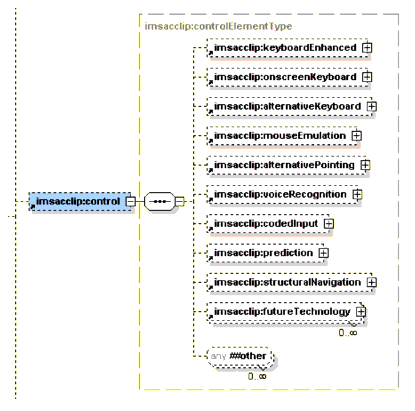
Implementation Notes
Examples
2.1.4 content: Element and complex Type
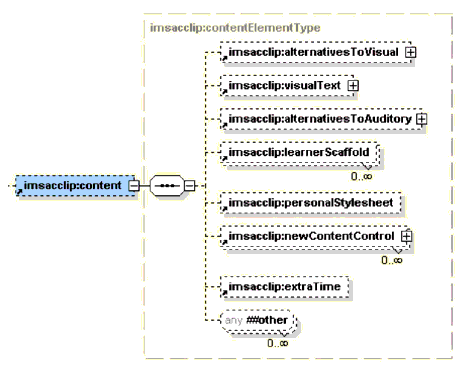
Implementation Notes
Examples
2.1.5 screenReader: Element and complex Type

Implementation Notes
Examples
2.1.6 screenEnhance: Element and complex Type

Implementation Notes
Note that all colors are bound as 4-octet hexadecimal strings (for example, "001122FF") representing RGBa values. The first octet ("00" in the previous example) is for red, the second octet ("11") is for green, the third octet ("22") for blue, and the last octet ("FF") for alpha. An alpha value of 00 is completely transparent, while an alpha value of FF is completely opaque.
Examples
2.1.7 textReadingHighlight: Element and complex Type

Implementation Notes
Examples
2.1.8 braille: Element and complex Type

Implementation Notes
Examples
2.1.9 tactile: Element and complex Type

Implementation Notes
Examples
2.1.10 visualAlert: Element and complex Type

Implementation Notes
Examples
2.1.11 structuralPresentation: Element and complex Type

Implementation Notes
Examples
2.1.12 keyboardEnhanced: Element and complex Type

Implementation Notes
Examples
2.1.13 onscreenKeyboard: Element and complex Type

Implementation Notes
Examples
2.1.14 alternativeKeyboard: Element and complex Type

Implementation Notes
Examples
2.1.15 mouseEmulation: Element and complex Type

Implementation Notes
Examples
2.1.16 alternativePointing: Element and complex Type

Implementation Notes
Examples
2.1.17 voiceRecognition: Element and complex Type

Implementation Notes
Examples
2.1.18 prediction: Element and complex Type
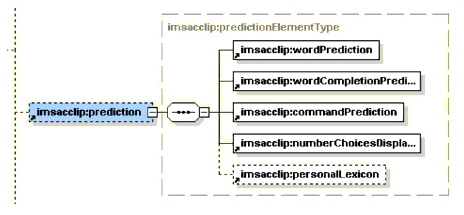
Implementation Notes
Examples
2.1.19 codedInput
Implementation Notes
Examples
2.1.20 structuralNavigation: Element and complex Type

Implementation Notes
Examples
2.1.21 alternativesToVisual: Element and complex Type

Implementation Notes
Examples
2.1.22 alternativesToText: Element and complex Type

Implementation Notes
Examples
2.1.23 alternativesToAuditory: Element and complex Type

Implementation Notes
Examples
2.1.24 visualText: Element and complex Type

Implementation Notes
Examples
2.1.25 learnerScaffold: Element and complex Type
Implementation Notes
Examples
2.1.26 personalStylesheet: Element and complex Type
Implementation Notes
Examples
2.1.27 futureTechnology: Element and complex Type

Implementation Notes
Examples
2.1.28 application: Element and complex Type
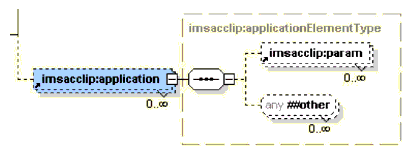
Implementation Notes
Examples
2.2 Extensions to Eligibility
2.2.1 accommodation: Element
Implementation Notes
Examples
2.2.2 accommodationPackage: Element
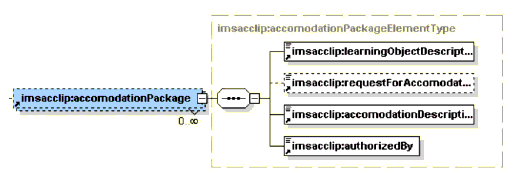
Implementation Notes
Examples
3. ACCLIP Element Mapping
This section contains several tables. Table 3.1 maps <accessForAll> elements by number and name as listed in the ACCLIP Information Model specification to the XML Schema entity used to represent it in the XML Schema binding. Table 3.2 does the same thing for <context> elements. The Schema entity's name, kind of structure, and type are provided. Note that all "usage" attributes are of type "usageType"; this is not explicitly noted in the table.
The ACCLIP Information Model identifies data elements in a dot-delimited enumeration and by name. The dot-delimited enumeration typifies the relationship of elements to each other, where elements with a numeral following a dot are subordinate to elements that share the same numeric value to the left of a dot. The enumeration typically does not imply a strict sequence or order of occurrence. It merely implies a group relationship.
Table 3.1 also includes references to additional XML Schema structures used to properly express the relationships or controlled lists of <accessibility> element values. These additional XML Schema structures are inserted into Table 3.1 in proximity to the <accessibility> elements they describe.
XSD elements of type complexType and simpleType may be nested. Table 3.1 does not show this nesting. Separate tables in this section provide the further details for nested elements defined as complexType or simpleType. In those tables, the element number from the Accessibility model and the XML Schema element name are used to associate a nested Schema structuring entity with the appropriate element from the Accessibility model.
| No. | IM Element Name | XSD Entity Name | XSD Structure | XSD Type |
|---|---|---|---|---|
| 1 | accessForAll | accessForAll | Element | accessForAllElementType |
| 1.1 | context | context | Element | contextElementType |
3.1 Mapping ACCLIP Vocabularies to XSD Entities of simpleType
| No. | XSD Name | XSD Base Type | Length |
|---|---|---|---|
| |
colorType | hexBinary | 4 |
4. Normative Points
4.1 XML Schema File Naming Conventions
Conformant with 1EdTech file naming conventions, an 1EdTech ACCLIP XML Schema binding instance shall be named according to this syntactical model: imsacclip_vmpn[pr[ps]].xsd , where
- "imsacclip_" signifies that the file pertains to the 1EdTech ACCLIP specification,
- "vm" is a major version of the 1EdTech ACCLIP specification defined by a binding instance, where "m" is the major version number, and is always followed by
- "pn", which signifies a minor version of the 1EdTech ACCLIP specification defined by a binding instance, where "n" is minor version number, and where
- [pr[ps]] is an optional set of major release and minor release numbers (as indicated by the brackets which are not part of the file name), depending on changes to schema instances themselves that are not driven by a change to a normative instance of the 1EdTech ACCLIP specification, with
- "pr" representing a major release component without an additional minor release part, where "r" is the major release number, and with
- "ps" representing a minor release component modifying an major release component, where "s" is the minor release number.
Non-normative examples of XML Schema file names for 1EdTech ACCLIP:
- "imsacclip_v1p0.xsd" is a binding tied to 1EdTech ACCLIP v1.0,
- "imsacclip_v1p0p1.xsd" is a 'major' revision of the imsss_v1p0.xsd binding instance,
- "imsacclip_v1p0p1p1.xsd" is 'minor' revision of imsss_v1p0p1.xsd binding instance.
4.2 Namespace URI (Namespace Identifier)
The namespace URI for 1EdTech ACCLIP shall be http://www.imsglobal.org/xsd/imsacclip
4.2.1 Location of Current 1EdTech ACCLIP Binding Instance
The.xsd file found at http://www.imsglobal.org/xsd/imsacclip/ shall be the current XML Schema binding instance of the 1EdTech ACCLIP Information Model normative elements and values. This file will change.
4.2.2 Location of Versioned 1EdTech ACCLIP Binding Instances
Versioned instances of each binding for 1EdTech ACCLIP, including all major or minor release instances of that version's binding, can be found at http://www.imsglobal.org/xsd/imsacclip/vmpn/, where "vmpn" is a folder named for a versioned instance of the specification. These instances will not change.
For example, the non-normative examples of XML Schema files named for various binding instances of 1EdTech ACCLIP v1.0 would be held at this location: http://www.imsglobal.org/xsd/imsss/v1p0/ .
4.3 Namespace Name
The namespace Name used as the prefix of an XML Namespace Qualified Name instance of an 1EdTech ACCLIP binding instance used in other XML documents shall be imsacclip.
For example, when declaring the 1EdTech ACCLIP namespace URI in an 1EdTech manifest, this attribute representation would be used:
xmlns:imsacclip="http://www.imsglobal.org/xsd/imsacclip"
An element of the 1EdTech ACCLIP declared in an XML document where the imsacclip namespace is declared would appear like this:
<imsacclip:accessForAll></imsacclip:accessForAll>
4.4 Versioning a Binding Instance
A binding version of the 1EdTech ACCLIP specification shall always reflect the current version number of the 1EdTech ACCLIP specification, whether or not binding structures change across specification instances. That is, the file name of the current binding instance shall share the same major and minor version number of the 1EdTech ACCLIP specification.
A change to binding structures without a related change to a specification version shall result in an increment of the major or minor revision level component of a binding's file name.
Changes to binding structures without a related change in a specification shall result in an increment of the major revision level.
Changes to structure names or values without changes in structures themselves or the meaning associated with a value shall result in an increment of the minor revision level.
All versioning and revisioning shall be reflected in a binding's file name and complete version information. This new binding shall become the current binding found at http://www.imsglobal.org/xsd/imsacclip. The obsolete binding shall be moved to its place within the imsacclip file path structure based on the value of its version level component, excluding the revision level component.
4.5 Localization
4.5.1 Localizing Binding Structure Names and Values
An 1EdTech ACCLIP binding's structure names and values shall be represented as depicted in the Tables within Section 3 of this document. This will ensure machine-level interoperability of accessibility information.
US English annotations and comment strings within an 1EdTech binding shall occur in all binding instances of an 1EdTech ACCLIP binding. Localized annotations and comments may be added to the US English annotations and comment strings within an 1EdTech binding as deemed necessary by 1EdTech stakeholders. Such localization activity in a binding shall promote a binding instance to the next increment in minor revision level.
4.5.2 Localizing this Document
This binding document may be rendered into different lingual representations except for the US English representations of:
- binding structure names
- binding structure values
- file naming syntax and examples
- binding namespace URI
- binding file path representation
- binding namespace name
Localization of this document shall not cause any change in specification version numbering or binding revision instance numbering.
4.6 Extensibility
The 1EdTech ACCLIP Binding provides several mechanisms for extending binding instances. There is a "wildcard" element contained in the following ACCLIP elements: <accessForAll>, <context>, <content>, <control>, <display>, <application>, and any element whose name ends in "Generic". Further, wildcard attributes are permitted on the following ACCLIP elements: <accessForAll>, <context>, <content>, <control>, <display>, and any element that has a "usage" attribute. All other extensions to binding instances are prohibited. This means:
- The 1EdTech ACCLIP XML Schema Definition File shall not be modified;
- Elements within the 1EdTech ACCLIP namespace shall not be modified;
- All elements in an instance document that are defined to be within the 1EdTech ACCLIP namespace shall conform exactly to the definition of that element provided in this binding description document;
- Elements in another namespace shall not be substituted for elements in the 1EdTech ACCLIP namespace (via the XML Schema substitution group mechanism, for example, or via any other mechanism);
- The vocabularies defined for elements and attributes within the 1EdTech ACCLIP namespace shall not be extended or restricted within the 1EdTech ACCLIP namespace.
The 1EdTech ACCLIP XML Schema Definition file enforces these restrictions by defining blockDefault="#all" on the root schema element in the 1EdTech ACCLIP namespace.
Further, extensions to the 1EdTech ACCLIP namespace are prohibited. This means:
The 1EdTech ACCLIP XML Schema Definition file enforces this restriction by defining namespace="##other" on all wildcard elements and attributes defined within the 1EdTech ACCLIP namespace.
As a potential aid to implementers, the types defined in the 1EdTech ACCLIP XML Schema Definition file may be imported into other namespaces and reused within those other namespaces. However, any such reuse shall be consistent with the restrictions defined in the 1EdTech ACCLIP specification document, and shall be consistent with the restrictions defined in this document.
About This Document
| Title | 1EdTech Learner Information Package Accessibility for LIP XML Schema Binding |
| Editor | Mark Norton |
| Team Co-Lead | Jutta Treviranus |
| Version | 1.0 |
| Version Date | 18 June 2003 |
| Status | Final Specification |
| Summary | This document describes the Learner Information Package - Accessibility Preferences |
| Revision Information | 18 June 2003 |
| Purpose | Defines the 1EdTech Learner Information Package - Accessibility Preferences. |
| Document Location | http://www.imsglobal.org/accessibility/acclipv1p0/imsacclip_bindv1p0.html |
List of Contributors
The following individuals contributed to the development of this document:
Revision History
Index
E
Elements
accessForAll 1, 2, 3
application 1, 2
content 1, 2
context 1, 2, 3
control 1, 2
display 1, 2
eligibility 1
Extensibility 1
I
1EdTech Specifications
Accessibility for LIP 1, 2, 3, 4, 5, 6, 7, 8
Learner Information Package 1, 2
Meta-Data 1
K
keyboard 1
X
XML 1, 2, 3, 4, 5, 6, 7, 8, 9, 10, 11
XSD 1, 2, 3, 4, 5, 6, 7, 8
1EdTech Consortium, Inc. ("1EdTech") is publishing the information contained in this 1EdTech Learner Information Package Accessibility for LIP XML Schema Binding ("Specification") for purposes of scientific, experimental, and scholarly collaboration only.
1EdTech makes no warranty or representation regarding the accuracy or completeness of the Specification.
This material is provided on an "As Is" and "As Available" basis.
The Specification is at all times subject to change and revision without notice.
It is your sole responsibility to evaluate the usefulness, accuracy, and completeness of the Specification as it relates to you.
1EdTech would appreciate receiving your comments and suggestions.
Please contact 1EdTech through our website at http://www.imsglobal.org
Please refer to Document Name: 1EdTech Learner Information Package Accessibility for LIP XML Schema Binding Revision: 18 June 2003


